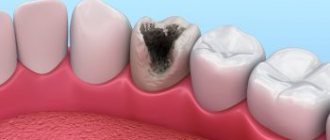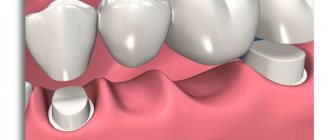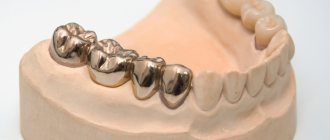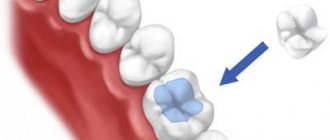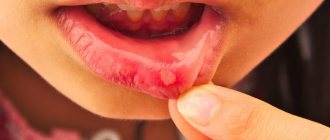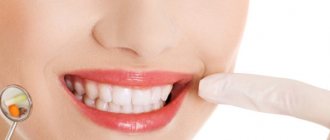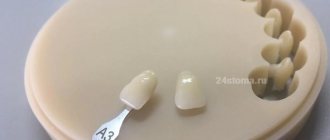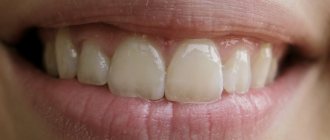Chief editor of the site:
Snitkovsky Arkady Alexandrovich
Chief physician of the professorial dentistry “22 Century”, dentist, orthopedic dentist
Author of the article:
Scientific team of dentistry “22 Century”
Dentists, candidates and doctors of medical sciences, professors
Stages of caries treatment
Caries is one of the most common lesions of the hard tissues of teeth, for which people go to the dental clinic. Let us examine in more detail the causes, types of this disease, as well as the stages of dental treatment .
Types of caries
Types of caries
Let us recall that the outside of the tooth is covered with enamel - the hardest tissue in the human body. Beneath it is dentin, which is similar in structure to bone tissue, but is characterized by greater mineralization. In the center of the tooth is the pulp - connective tissue with many vessels and nerve endings.
Depending on the depth of the lesion, there are:
Caries in the spot stage
There is no visible defect in the hard tissues of the tooth. The affected area differs from the healthy one in that it is lighter, more cloudy, and has slight roughness. This occurs due to demineralization (loss of calcium) of the enamel. In this case, the person does not experience any sensations.
Superficial caries
At this stage, a defect is formed that affects only the enamel layer. Significantly different from healthy tooth tissue, it is a cavity or depression of a dirty gray color with a rough bottom. The patient may complain of sensitivity when consuming cold or hot foods.
Average caries
There is a medium-sized cavity filled with softened dentin and food debris. Painful sensations are possible when taking sour or sweet foods and a reaction to a temperature stimulus may occur. The pain goes away quickly. Sometimes this form is completely painless.
Deep caries
It is characterized by extensive damage to the hard tissues of the tooth, involving the deep layers of dentin. Clinically expressed by the presence of a cavity filled with softened tooth tissue and food debris.
Complaints most often include sharp pain arising from temperature (cold, hot), chemical (sweet, sour) and mechanical (chewing) stimuli. When the influencing factor is eliminated, the pain goes away.
Caries can also be primary or secondary (which appears on previously treated teeth).
In the world of economic and social competition, it is simply necessary to have a pleasant appearance. Some patients, realizing that beautiful, white, healthy teeth are an element of modern culture, a symbol of youth, health, beauty and success, turned to the dentist with a request to recreate a Hollywood smile, thereby promoting doctors to understand what methods and materials will help them improve the appearance of their patients. Nowadays, therapeutic dentistry, taking into account the importance of aesthetics, is developing a large number of treatment methods and using various types of filling materials.
Knowing the anatomical features of the tooth and the color rendering properties of the material you are working with, you can perform any complex aesthetic restoration.
The purpose of the study is to demonstrate a method for restoring class III cavities (according to Black) with modern materials using minimally invasive preparation techniques.
Material and methods
M. contacted the specialized department of the Department of General and Aesthetic Dentistry of the Moscow State Medical University
23 years old, with complaints of food debris getting and getting stuck between teeth 2.1 and 2.2. When collecting anamnesis, it turned out that the patient did not have an allergic reaction to the drugs and there was no concomitant pathology of the internal organs (cardiovascular system, gastrointestinal tract, endocrine and nervous systems). According to the patient, two years ago she sought help from a dentist with complaints of nightly, prolonged pain from all types of irritants in the area of tooth 2.1. Endodontic treatment was performed. Over the past 2 months, the patient has noted food getting and getting stuck between teeth 2.1. and 2.2.
Upon external examination, the configuration of the face is not changed, regional lymph nodes (submandibular, mental and posterior cervical) are not palpable.
When examining the oral cavity, the mucous membrane is pale pink in color and moderately moist.
When examining tooth 2.1, a carious cavity is noted on the distal contact surface, filled with softened dentin, the filling on the palatal surface is sound, the color is not changed, the marginal fit is not broken (Fig. 1).
Figure 1. Initial view of tooth 2.1 before restoration.
To control the previously performed endodontic treatment, an X-ray examination of tooth 2.1 was carried out, according to which the root canal is obturated to the physiological apex, evenly, in the area of the apical foramen there is an expansion of the periodontal fissure (Fig. 2).
Figure 2. X-ray of tooth 2.1.
Based on the data obtained, a diagnosis was made: tooth 2.1 - condition after complete removal of the pulp, according to ICD-10 - dentin caries K 02.1.
Before starting treatment on the tooth surface 2.1. Soft plaque was removed and the tooth color was determined using the VITA scale. Under infiltration anesthesia Sol. Ultracaini DS forte 4% 0.8 ml formed a class III cavity (according to Black) with an additional platform and fold within the enamel on the palatal surface of tooth 2.1. To control the quality of mechanical treatment of the carious cavity, a caries detector was used (Fig. 3).
Figure 3. Application of a caries detector.
To improve the quality of the restoration, tooth 2.1 was isolated from the oral fluid using an optradam (Fig. 4).
Figure 4. Tooth 2.1 - optradam insulation.
The prepared cavity was treated with a 2% chlorhexidine solution. After adding the VII generation adhesive system, the first layer was a low-modulus light-curing composite material of shade A3, the main volume of the carious cavity was filled with opalescent shade OA3, the last layer was filled with enamel shade A3. Next, the restoration was finished with a brush and polishing paste (Fig. 5).
Figure 5. Finishing of the tooth restoration 2.1.
The final view of the restoration of tooth 2.1 from the palatal and vestibular sides (Fig. 6, 7).
Figure 6. Tooth 2.1, view of the restoration from the palatal surface.
Figure 7. Tooth 2.1, view of the restoration from the vestibular surface.
Thus, this clinical case illustrates that the use of modern composite materials, the correct implementation of hard tissue preparation techniques, and compliance with recommendations for selecting colors taking into account knowledge of tooth anatomy undoubtedly play a key role in recreating an aesthetic restoration.
Stages of caries treatment in dentistry
Conversation with a doctor
The doctor asks in detail what worries the patient, when and how the complaints appeared. Collects information about the general condition of the body, the presence of chronic diseases, and allergic reactions.
Oral examination
Examination of the oral cavity
The condition of the dentition , oral mucosa, and level of hygiene are assessed Then a thorough examination of the “causal” tooth is carried out. A preliminary diagnosis is made
Oral hygiene
At this stage, teeth are cleaned from soft plaque with special brushes and paste. In the presence of hard dental plaque, ultrasonic attachments are used.
Further stages of treatment will depend on the type of caries .
For caries in the spot stage, remineralization procedures are carried out after oral hygiene. Its essence lies in saturating the enamel with minerals that were lost during the carious process.
The tooth is dried, then applications are made with solutions containing 10% calcium gluconate. This procedure is repeated several times. Afterwards, a tampon with a 0.2% sodium fluoride solution is applied. As a result, a layer of fluoroapatite elements is gradually formed, and the enamel is saturated with all the necessary components.
Fluoridation of enamel
Fluoride ions form a protective layer that protects the enamel from external adverse factors, and also prevents the loss of important microelements.
There are several types of fluoridation:
- Using fluoride varnish - the tooth is coated with varnish using a brush;
- Mouth guards - a custom-made mouth guard that follows the dentition is made. It is filled with gel and worn for a certain time. This procedure can be performed at home as recommended by your doctor.
Enamel sealing liquid
It is a system that includes two solutions. In the first, the active substance is a fluorine-containing agent, in the second, calcium hydroxide.
After oral hygiene, the first solution is applied to the dried tooth surface, then the second.
This procedure provides deep fluoridation of hard tooth tissues. It differs from conventional fluoridation in that during the action on the enamel, small particles of calcium fluoride are formed. Due to this, they penetrate deeper into the pores. Packed in a gel and thereby protected from mechanical stress, they constantly release fluoride, which, together with the mineral salts of saliva, ensures long-term remineralization, enhancing it almost 100 times.
Next, we will consider the treatment of medium and deep caries.
Anesthesia
Anesthesia in dentistry
The choice of drug and type of anesthesia depends on the individual sensitivity threshold, the presence of an allergic reaction or other characteristics of the body, as well as on the specific clinical situation.
When treating caries, the following types of anesthesia are distinguished:
Appliqué
It affects nerve endings located in the superficial layer of the mucous membrane. Used to relieve pain at the point of needle insertion. It comes in the form of a spray or gel.
Infiltration
The most used type in the treatment of caries. In the projection of the apex of the tooth root, an anesthetic is injected along the transitional fold. The nerve endings of the causative tooth are switched off, as well as possible anastomoses (interweavings, intersections of nerve fibers of neighboring teeth).
It is most effective when used on the upper jaws, since the bone is more porous, therefore the drug penetrates better inside and affects the nerve fibers.
Conductor
Can be used in the treatment of large molars of the lower jaw. More often, mandibular anesthesia is used, in which the mandibular nerve is switched off. Clinically, this is manifested by numbness of half the lower lip, the tip of the tongue, and lack of sensitivity of the teeth on the side where anesthesia is administered.
Tooth preparation and cavity formation
At this stage, the affected areas of the hard tissues of the tooth are removed using a drill. Then a cavity is formed depending on the topography of the carious process.
Isolating the tooth from saliva
Cotton and gauze swabs and a saliva ejector are used. Many doctors also use a rubber dam, a latex plate designed to isolate one or more teeth being treated from the rest of the mouth during treatment. The advantages of its use are that it ensures absolute dryness of the working area, protects the mucous membranes of the cheeks, tongue, lips from the effects of various dental reagents, and protects the patient’s pharynx and respiratory tract.
Medicinal treatment, etching of enamel and dentin
The formed cavity is treated with antiseptic solutions, then with a special gel containing orthophosphoric acid, washed and thoroughly dried. This ensures good permeability of hard tooth tissues.
Application of adhesive
To improve the fixation of the filling material, the enamel and dentin are treated with a special adhesive, allowed to absorb, and then illuminated with a photopolymerization lamp.
Applying a gasket under the filling
The following types of gaskets are distinguished:
Medical
It is a preparation based on calcium hydroxide. Used for deep carious cavities close to the pulp. It is believed that due to the pronounced alkaline reaction of the drug, the blood circulation of the pulp is normalized and intensive deposition of replacement dentin occurs.
But it should be noted that medicinal pads do not have adhesion to dentin, therefore, the connection of the filling with the dental tissues will be defective. Also, the risk of secondary caries is higher when using such pads (if they get on the walls of the cavity).
Preparation of class I carious cavities using black
Class
I
- cavities in the area of fissures and natural recesses (small and large molars, incisors).
Rice. Class I cavities (diagram)
a – chewing surface of the molar; b – chewing surface of the premolar; c – vestibular surface of the molar; d – lingual surface of the molar; d – lingual surface of the incisor.
Cavity opening
First stage of preparation.
Target:
— creating full access to all necrotic and demineralized tissues;
- creating a good image of the cavity.
Burs used:
spherical, fissure, pear-shaped, etc.
REMEMBER!
The size of the bur should match the diameter of the inlet or be slightly smaller than the inlet, at high speed (preferably using a turbine unit, with air-water cooling).
Opening the carious cavity involves removing all overhanging and undermined edges of the enamel that do not have dentin support underneath, until vertical walls are obtained (created).
Criterion
– absence of undermined enamel edges.
